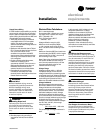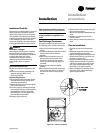
PKG-SVX14A-EN 27
• To assist in reducing power generation
emissions, always attempt to improve
equipment performance with improved
maintenance and operations that will
help conserve energy resources.
WARNING
Confined Space Hazards!
Do not work in confined spaces where
sufficient quantities of refrigerant or
other hazardous, toxic, or flammable
gas may be leaking. Refrigerant or
other gases could displace available
oxygen to breathe, causing possible
asphyxiation or other serious health
risks. Some gases may be flammable
and or explosive. Evacuate the area
immediately and contact the proper
rescue or response authority. Failure
to take appropriate precautions or to
react properly to a potential hazard
could result in death or serious injury.
WARNING
Hazard of Explosion!
Use only dry nitrogen with a pressure
regulator to pressurize the unit. Do not
use acetylene, oxygen, compressed
air, or mixtures containing them.
Do not use mixtures of a hydrogen
containing refrigerant and air above
atmospheric pressure for pressure
testing as they may become
flammable and could result in an
explosion. Refrigerant, when used as
a trace gas should only be mixed with
dry nitrogen for pressurizing units.
Failure to follow these
recommendations could result in
death, serious injury, equipment, or
property-only damage.
WARNING
Leak Testing!
Do not exceed 200 psig when leak
testing system. Failure to follow these
instructions could result in an
explosion causing death or serious
injury.
Refrigerant System
Special Note on Refrigerant Emissions
Follow the Trane recommended
procedures on operation, maintenance,
and service to ensure refrigerant
conservation and emission reduction.
Also, pay specific attention to the
following:
• Whenever removing refrigerant from
equipment, recover for reuse, recycle,
reprocess (reclaim), or properly destroy
it.
• Always determine possible refrigerant
recycling or reclaiming requirements
before beginning recovery. Questions
about recovered refrigerants and
acceptable refrigerant quality
standards are addressed in ARI
Standard 700.
• Use approved containment vessels and
safety standards. Comply with all
applicable transportation standards
when shipping refrigerant containers.
• To minimize emissions while recovering
refrigerant, use recycling equipment.
Always attempt to use methods that
pull the lowest possible system vacuum
while recovering and condensing
refrigerant into containment.
• When leak checking with trace
refrigerant and nitrogen, use HCFC22
(R22) rather than CFC12 (R12) or any
other fully halogenated refrigerants. Be
aware of any new leak test methods
that eliminate refrigerant as a trace gas.
• When cleaning system components or
parts, do not use CFC11 (R11) or
CFC113 (R113). Refrigeration system
clean up methods using filters and
dryers are recommended. Do not use
solvents that have ozone depletion
factors. Properly dispose of used
materials.
• Take extra care to properly maintain all
service equipment directly supporting
refrigerant service work such as
gauges, hoses, vacuum pumps, and
recycling equipment.
• Stay aware of unit enhancements,
conversion refrigerants, compatible
parts, and manufacturer’s
recommendations that reduce
refrigerant emissions and increase
equipment operating efficiencies.
Follow specific manufacturer’s
guidelines for conversion of existing
systems.
In the event of required system repair,
leak test the liquid line, evaporator coil,
and suction line at pressures dictated by
local codes, and using the following
guidelines.
1. Charge enough refrigerant and dry
nitrogen into the system to raise the
pressure to 100 psig.
2. Use a halogen leak detector, halide
torch, or soap bubbles to check for
leaks. Check interconnecting piping
joints, the evaporator coil connections,
and all accessory connections.
3. If a leak is detected, release the test
pressure, break the connections and
reassemble it as a new joint, using
proper brazing techniques.
4. If no leak is detected, use nitrogen to
increase the test pressure to 150 psig
and repeat the leak test. Also, use soap
bubbles to check for leaks when
nitrogen is added.
5. Retest the system to make sure new
connections are solid.
6. If a leak is suspected after the system
has been fully charged with refrigerant,
use a halogen leak detector, halide
torch, or soap bubbles to check for
leaks.
Refrigerant Evacuation
For field evacuation, use a rotary style
vacuum pump capable of pulling a
vacuum of 100 microns or less.
When connecting the vacuum pump to a
refrigeration system, it is important to
manifold the pump to both the high and
low side of the system. Follow the pump
manufacturer’s directions.
WARNING
Use of Pressure Regulator –
Valves – Gauges!
Always use pressure regulators,
valves, and gauges to control drum
and line pressures when pressure
testing equipment. Failure to follow
these instructions could result in an
explosion causing death, serious
injury, or equipment damage.
Maintenance
maintenance
procedures


















